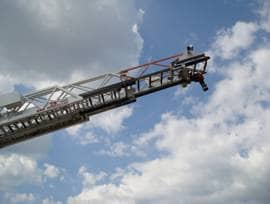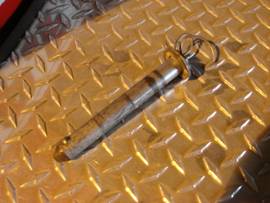NIOSH Safety Advisory: Improper Set-up of Aerial Ladders with a Locking Waterway May Put Firefighters at Risk
NIOSH Safety Bulletin -- NIOSH recommends that all fire departments utilizing aerial ladder trucks with locking (pin-anchored, lever actuated, clamped) waterways immediately take the following actions to reduce the risk of fire fighters being struck by unsecured waterways or parts of the waterway:
- Ensure that Standard Operating Procedures (SOPs) and/or Guidelines (SOGs) on setting up multi-position waterways include steps to properly position the waterway and to inspect and verify that the locking mechanism (anchoring pin(s), lever, clamps, etc.)
are properly installed and functioning
as designed before pressurizing the waterway. - Properly train and practice the correct method of securing waterways and verifying they are secured (per manufacturer’s recommendations).
- Download the Safety Bulletin (PDF)
NIOSH is currently investigating an April 8, 2008 fire fighter line-of-duty-death that illustrates that adhering to manufacturer recommended set-up procedures for aerial ladder operations is paramount to ensuring fire fighter safety. properly seated pin at the fly section

Photo 1 - A properly seated pin at the fly section for defensive water stream operations is highlighted in the red circle. The hole behind it (yellow arrow) shows the location where the pin would be inserted (from the top) to keep the monitor assembly back at the second ladder section for rescue mode. NOTE: Various methods are used throughout the fire apparatus industry to secure the waterway: this picture represents a pin-anchored waterway design.Preliminary findings in this investigation suggest that some equipment designs do not provide secondary stops for the waterway on aerial ladders. Thus, failure to properly secure the waterway in the proper position can lead to catastrophic waterway failure and possible serious or fatal injury to fire fighters working in the area. The pin-anchored waterway design involved in this particular investigation is not limited to a single model or apparatus manufacturer. NIOSH is aware of at least 7 similar incidents that occurred in Delaware, Michigan, New Jersey, Texas, Virginia and Ontario without serious injury. Newer aerial ladder trucks may incorporate different types of anchoring mechanisms and/or a more fail-safe design but proper set up still needs to be verified before operation.
Circumstances of incident under investigation by NIOSH
On April 8, 2008, a volunteer Deputy Fire Chief (the Incident Commander), was killed when struck by a motorized water monitor and 30 feet of aluminum pipe that was "launched" off an elevated aerial ladder at a fire at an industrial manufacturing plant in Pennsylvania. The truck was normally transported in the "rescue mode" with the monitor pinned to the second section of ladder so that the waterway would not be in the way if the ladder was set up for rescue operations.
At the incident scene, when the waterway was pressurized, the monitor and its support bracket, along with the last 30-foot section of pipe were "launched" off the aerial ladder by the force of the water pressure in the pipe. The monitor flew approximately 75 feet and fell, striking the Incident Commander on the head, killing him instantly. After the incident, the anchor pin was found on the ground, in front of the truck’s cab. The waterway did not include any secondary mechanical stops to prevent the separation of the water monitor in the event the anchoring pin was not properly seated. The NIOSH Fire Fighter Fatality Investigation and Prevention Program is currently investigating this incident and a full report will be available at a later date.
NIOSH would like to bring this information to the attention of all U.S. fire departments and fire fighters who operate or work around aerial ladder trucks with locking (pin-anchored, lever actuated, clamped) waterways so that future occurrences of waterway monitor "launches" or the unexpected movement of the waterway monitor can be prevented.
If secondary mechanical stops are present, the unexpected impact of the waterway monitor against the mechanical stop could cause structural damage to the aerial ladder and jeopardize the safety of any fire fighter standing on the aerial ladder. While not a contributing factor in the fatal incident, NIOSH reminds fire departments to comply with relevant federal regulations and NFPA standards for fire apparatus inspections and certification.


Photo 2 – Aerial ladder with monitor at tip
Photo 3 – anchoring pin 

Photo 4 – Monitor and pipe that “launched” Photo 5 - The receiver assembly where the pin is
inserted
Tags:
Specialty Websites
Find Members Fast
Firefighting Videos
© 2025 Created by Firefighter Nation WebChief.
Powered by
![]()
Badges | Contact Firefighter Nation | Privacy Policy | Terms of Service